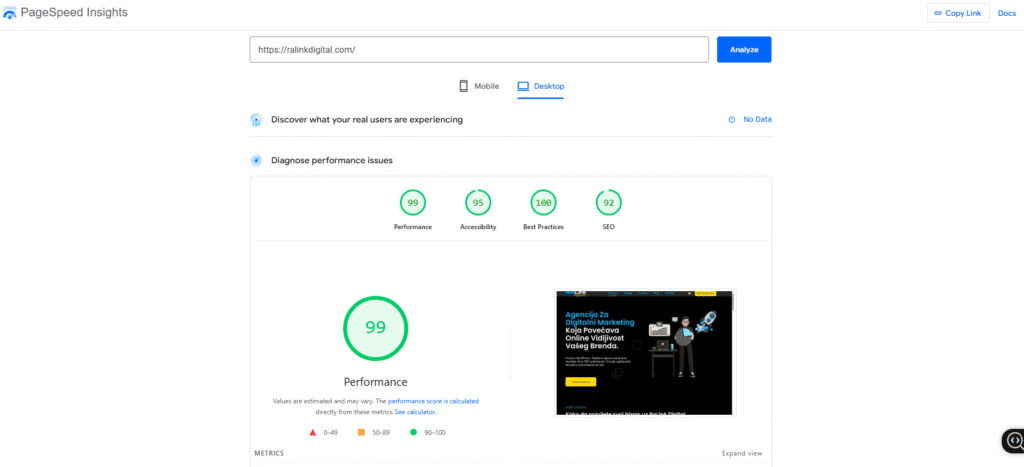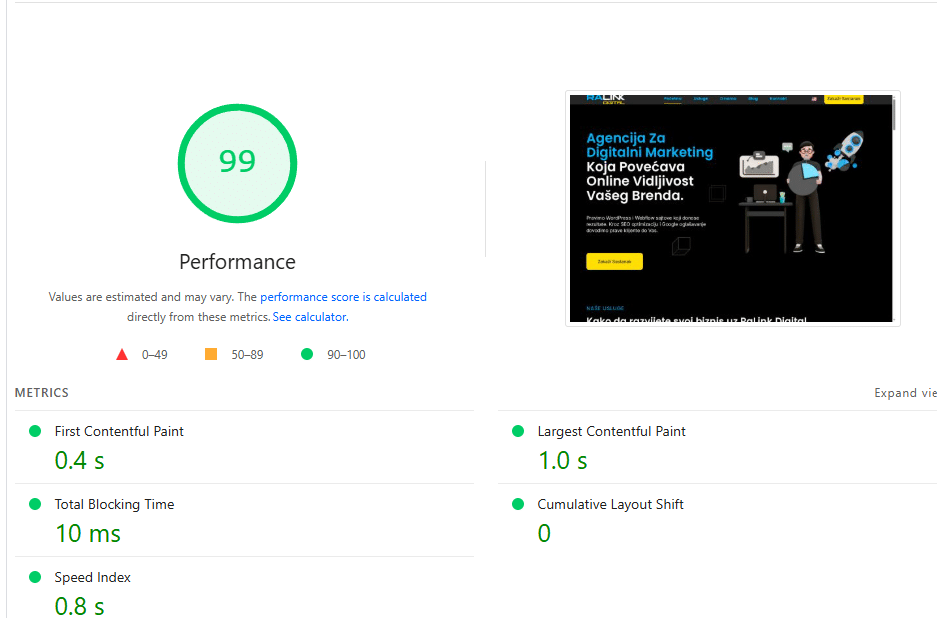Why Less Can Be More When It Comes to Websites
In a world overloaded with information, simplicity has become a luxury. When it comes to websites, focusing on essential elements often delivers better results than trying to include everything possible.
After years in digital marketing, we’ve seen thousands of websites. Some had every possible feature but failed to capture visitors’ attention. Others were simple yet incredibly effective in converting visitors into clients.
The difference between successful and unsuccessful websites often lies in how well a few key functions are executed—not in trying to be everything to everyone. When local businesses seek professional website design in Novi Sad, they often focus on the wrong priorities.
Today’s users have short attention spans—on average, just 5 seconds to decide whether to stay on your site or leave. Within that short window, your site must clearly communicate who you are, what you do, and why the visitor should stay.
A skilled digital marketing agency understands that every element on a website must serve a clear purpose. It’s not about how many features you have, but how well they serve your business goals and user needs.
That’s why we’ve highlighted the 5 most important elements every website must include. These are the foundation of a successful online presence, whether you’re a small local business or a large corporation.
1. Responsive Design – The Foundation of a Modern Website
Why Responsive Design Is Now a Must, Not an Option
Ten years ago, responsive design was a luxury reserved for the most advanced websites. Today, it’s a necessity—over 65% of all internet searches are performed on mobile devices.
Since 2021, Google has implemented “mobile-first indexing,” meaning it evaluates the mobile version of your site first when determining rankings. A website not optimized for mobile automatically falls behind, no matter how great the content is.
However, responsive design isn’t just about fitting the site to a smaller screen. It’s a complex process that includes reorganizing content, adjusting navigation, optimizing images, and ensuring that all functionalities work seamlessly across all devices.
What Makes Truly Good Responsive Design?
A digital marketing agency designing a responsive website must consider three main breakpoints: desktop (over 1024px), tablet (768px–1024px), and mobile (up to 768px). But true professionals go further and test the website on real devices.
Fun fact: the average user holds a phone 30–40 cm from their face, so buttons must be large enough to tap easily. Apple recommends a minimum size of 44×44 pixels for touch elements, while Google recommends 48×48 pixels.
Load speed on mobile devices is critical. Mobile users are even more impatient than desktop users—53% abandon a page if it doesn’t load within 3 seconds. This means responsive design must be optimized both visually and in terms of performance.
Common Responsive Design Mistakes
One of the most common mistakes is hiding content on mobile devices. Many designers think removing sections makes a site more “mobile-friendly.” But mobile users want the same information as desktop users—they just look for it differently.
Another frequent error is neglecting load speed. A responsive site that loads large images meant for desktops on mobile loses its purpose. Modern techniques like lazy loading and using different image sizes for different devices are essential.
Navigation is a particular challenge. The hamburger menu has become standard, but it must be implemented thoughtfully. Users should intuitively understand that those three lines hide the navigation.
How to Test Responsive
Design Professional web development includes thorough testing on real devices. Browser developer tools are a good starting point, but they can’t replace testing on actual phones and tablets.
Different browsers render sites differently, especially on mobile. Safari on iPhones may behave differently than Chrome on Android devices. These differences can be subtle but critical to the user experience.
Google PageSpeed Insights and GTmetrix provide detailed performance analyses on mobile. These tools don’t just measure speed; they also offer specific recommendations for improvement.ž
2. Load Speed – The Invisible Factor That Determines Success
Why Every Second Counts
Website loading speed may be the most invisible yet most critical success factor. Amazon found that every 100ms delay in loading time cost the company 1% in revenue—that’s over a billion dollars annually.
Google has made it clear that speed is a major ranking factor. Its “Page Experience” algorithm directly includes Core Web Vitals—metrics that evaluate load speed, interactivity, and visual stability.
When a user clicks a link, their brain starts counting. First second—expectation. Second second—impatience. Third second—considering leaving. Fourth second—clicking the back button. This psychology makes speed vital for retaining visitors.
What Affects Site Speed?
Hosting is the foundation of your website’s speed. Cheap shared hosting may cost just a few euros per month but can cost thousands in lost opportunities. High-quality hosting with SSDs and ample resources is an investment, not an expense.
Images often account for 60–70% of a webpage’s size. A single unoptimized 5MB image can slow down the entire site. Modern compression techniques can reduce image sizes by up to 80% without visible quality loss.
The site’s code also plays a big role. Excess JavaScript, unoptimized CSS, and too many plugins can dramatically slow down a site. In professional web development, every line of code is carefully considered.
Measuring and Optimizing Speed
Google PageSpeed Insights is a free tool that analyzes your website’s speed and gives actionable recommendations. It measures real user experience through Core Web Vitals:

Largest Contentful Paint (LCP) – how quickly the main content loads. Ideal: under 2.5 seconds.
First Input Delay (FID) – how responsive the site is to user interaction.
Cumulative Layout Shift (CLS) – measures visual stability; do elements shift during loading?

GTmetrix offers a more detailed analysis, showing a waterfall diagram of load order for all elements. This helps identify specific problems slowing down the site.
Advanced Optimization Techniques
A Content Delivery Network (CDN) distributes your content across servers worldwide. When a user from Novi Sad visits your site, content is loaded from the nearest server, drastically reducing load times.
Lazy loading allows images to load only when users scroll to them. This technique can significantly improve initial load time, especially on image-heavy pages.
Caching stores a static version of your pages and serves them without needing to regenerate from the database each time. This can speed up your site by up to 10 times.
Mobile Speed – A Special Challenge
Mobile devices have limited processing power and often use slower internet connections. A site that loads fast on desktop can be slow on a phone.
Progressive Web Apps (PWAs) combine the best of websites and mobile apps. They can work offline, send push notifications, and load incredibly fast.
Speed’s Impact on SEO
SEO optimization must include speed optimization because Google uses speed as a direct ranking factor. A slow site will not rank well, no matter how good the content is.
Bounce rate is directly linked to speed. Users who leave due to slow loading send a negative signal to Google about site quality.
Time spent on site also depends on speed. A faster site allows users to explore more pages—something Google interprets as a quality signal.
SEO Optimization – Be Found, Not Just Seen
Why SEO Is No Longer Optional – It’s Essential
Think of SEO like a city’s infrastructure—you don’t notice it when it works, but everything falls apart when it doesn’t. You can have the most beautiful website in the world, but if no one finds it on Google, it might as well not exist.
The stats are brutal: 75% of users never go past the first page of Google results. If your business isn’t ranking in the top 10 for the right keywords, you’re losing a steady stream of potential clients—every single day.
Google handles over 8.5 billion searches per day. Each one represents someone actively looking for a solution. SEO ensures your business shows up at the exact moment a potential customer is searching for what you offer.
How Modern SEO Works
Google’s algorithm considers over 200 factors when ranking websites. Some of the most important include content quality, site speed, mobile-friendliness, security (HTTPS), user experience, and domain authority.
Google now emphasizes E-A-T—Expertise, Authoritativeness, and Trustworthiness. Your website needs to demonstrate subject-matter expertise, be recognized as a trustworthy source, and build real authority in your niche.
For businesses in local markets like Novi Sad, local SEO is a game changer. A well-optimized Google Business Profile, consistent NAP (Name, Address, Phone), local reviews, and geo-targeted keywords can dramatically improve local visibility.
On-Page SEO – Optimization You Can See
· Title Tags: These are like book titles—they should grab attention and clearly reflect what the page is about. The ideal length is 50–60 characters, with the main keyword at the front.
· Meta Descriptions: Think of this as your elevator pitch in Google results. In 150–160 characters, tell users why they should click your link. Include the keyword, a benefit, and a strong call to action.
· Header Tags (H1, H2, H3): Structure your content like chapters in a book. Each page should have one unique H1 tag containing the main keyword, while H2 and H3 tags break down the content into readable sections.
Content That Google Loves
Google prioritizes content that provides better answers than the competition. That means understanding what your audience is actually searching for—and creating content that fully meets their intent.
Keyword research isn’t just about finding popular terms. You need to understand search intent—is the user looking for information, ready to buy, or seeking a specific site? Different intents require different types of content.
Technical SEO – The Foundation You Don’t See
· XML Sitemap: This is your site’s roadmap for Google. It helps search engines find and index all your pages. It should be kept up to date and submitted via Google Search Console.
· Robots.txt: This file tells search engines what they can and cannot index. A misconfigured robots.txt can accidentally block your entire site.
· Structured Data (Schema Markup): This helps Google understand your content better and can lead to enhanced listings (like reviews, pricing, or events) in search results.
Linking – Digital Votes of Confidence
· Backlinks: These are like real-world recommendations. The more high-quality sites link to you, the more authority Google assigns to your website. But quality trumps quantity.
· A single backlink from a trusted site (like Politika.rs) is more valuable than 100 links from unknown blogs. Google also detects and penalizes manipulative link-building tactics.
· Internal Linking: This connects your pages and helps Google understand your site’s structure. A good internal linking strategy improves the rankings of multiple pages across your site.
Measuring SEO Success
- Use Google Search Console to see how Google views your site—what keywords you rank for, how many clicks you’re getting, and whether there are any technical issues.
- Ranking is only part of the story. Your click-through rate (CTR) tells you how effective your titles and descriptions are. Your bounce rate shows whether visitors are finding what they expected.
When a digital agency manages SEO, it tracks organic traffic, conversions from search, and ranking improvements for target keywords. Results usually begin to show after 3–6 months of consistent effort—but they compound over time.
4. Security and Trust – Protecting Your Business in the Digital World
SSL Certificates – The Foundation of Modern Web Security
HTTPS is no longer optional—it’s the baseline. Google Chrome labels all non-HTTPS sites as “Not Secure,” which instantly damages trust. Over 84% of users say they’ll leave a site when they see a security warning.
An SSL certificate encrypts all data between your website and your visitors. This is critical for any site collecting forms, logins, or payments. Beyond safety, Google also gives a ranking boost to HTTPS-enabled websites, making SSL both a trust and an SEO asset.
Backups – Insurance for Your Digital Business
60% of small businesses never recover after a major data loss. Daily, automated backups stored in multiple secure locations are not a luxury—they’re your digital insurance policy.
Smart web development starts with a solid backup system. Follow the 3-2-1 rule:
3 copies of your data
on 2 different types of storage
with 1 copy stored off-site
Updates & Monitoring – Don’t Leave the Door Open
Over 40% of all websites run on WordPress, making it a prime target for hackers. Outdated themes, plugins, or core files can act as open doors for malware and attacks.
A well-built website comes with an update strategy and active monitoring in place. Daily malware scans help catch threats before they spread, and Google Search Console can alert you to suspicious activity—often before users even notice.
Final Thoughts – A Smart Investment in Your Business Future
In the digital landscape of 2025, a website is no longer just an online business card—it’s your most powerful sales tool. The five key elements we’ve covered work together as a unified system that attracts, engages, and converts visitors into paying customers.
Responsive design ensures that your site works flawlessly across all devices. Load speed determines whether visitors stay long enough to explore your offer. SEO optimization makes sure potential clients find you right when they need your services. Security builds the trust that underpins every successful business relationship. And a clear call-to-action transforms interest into measurable results.
Each element may seem simple on its own—but executing them well requires expertise and precision. A misstep in any area can cost you thousands in lost opportunities.
When choosing a partner for your website, look for an agency that understands the complexity of modern web design. It’s not enough for a site to just “look good”—it must function as a well-oiled machine built to deliver results.
A marketing agency that truly understands your business won’t just provide technical solutions. They’ll create a custom strategy that balances all five core elements with your business goals and audience needs.
Investing in a high-performance website is not a cost—it’s a long-term asset. In a world where more and more business happens online, a site that gets these five essentials right can be your competitive edge.
Don’t let your competition leave you behind. Every day without a modern, optimized website is a missed opportunity for growth.
Want a website that checks all the boxes? Let’s talk. Book your free consultation today.



